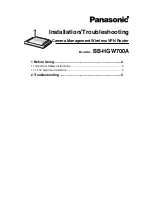
87
Appendix A: Troubleshooting
Common Problems and Solutions
Wireless-G Router for Mobile Broadband
•
If you get a reply, the computer is connected to the Internet. If you cannot open a webpage, try the ping
command from a different computer to verify that your original computer is not the cause of the problem.
•
If you do NOT get a reply, there may be a problem with the connection. Try the ping command from a
different computer to verify that your original computer is not the cause of the problem.
4. I am not getting an IP address on the Internet with my Internet connection.
•
Refer to “Problem #3, I want to test my Internet connection” to verify that you have connectivity.
•
If you need to register the MAC address of your Ethernet adapter with your ISP, please see “Appendix E:
Finding the MAC address and IP Address for Your Ethernet Adapter.” If you need to clone the MAC address
of your Ethernet adapter onto the Router, see the System section of “Chapter 8: Configuring the
Wireless-G Router for Mobile Broadband” for details.
•
Make sure you are using the right Internet connection settings. Contact your ISP to see if your Internet
connection type is DHCP, Static IP Address, or PPPoE (commonly used by DSL consumers). Please refer to
the Setup section of “Chapter 8: Configuring the Wireless-G Router for Mobile Broadband” for details on
Internet connection settings.
•
Make sure you have the right cable. Check to see if the Internet column has a solidly lit Link/Act LED.
•
Make sure the cable connecting from your cable or DSL modem is connected to the Router’s Internet port.
Verify that the Status page of the Router’s web-based utility shows a valid IP address from your ISP.
•
Turn off the computer, Router, and cable/DSL modem. Wait 30 seconds, and then turn on the Router,
cable/DSL modem, and computer. Check the Status tab of the Router’s web-based utility to see if you get
an IP address.
5. I am not able to access the Setup page of the Router’s web-based utility.
•
Refer to “Problem #3, I want to test my Internet connection” to verify that your computer is properly
connected to the Router.
•
Refer to “Appendix E: Finding the MAC Address and IP address for Your Ethernet Adapter” to verify that
your computer has an IP Address, Subnet Mask, Gateway, and DNS.
•
Set a static IP address on your system; refer to “Problem #2: I need to set a static IP address.”
•
Refer to “Problem #10: I am a PPPoE user, and I need to remove the proxy settings or the dial-up pop-up
window.”
6. I need to set up a server behind my Router and make it available to the public.
To use a server like a web, ftp, or mail server, you need to know the respective port numbers they are using.
For example, port 80 (HTTP) is used for web; port 21 (FTP) is used for FTP, and port 25 (SMTP outgoing) and
port 110 (POP3 incoming) are used for the mail server. You can get more information by viewing the
documentation provided with the server you installed.
Follow these steps to set up port forwarding through the Router’s web-based utility. We will be setting up
web, ftp, and mail servers.
1. Access the Router’s web-based utility by going to http://192.168.1.1 or the IP address of the Router.
Go to the Applications & Gaming => Port Range Forward tab.
Summary of Contents for WRT54G3G-ST
Page 128: ...119 Appendix I Regulatory Information Wireless G Router for Mobile Broadband...
Page 129: ...120 Appendix I Regulatory Information Wireless G Router for Mobile Broadband...
Page 130: ...121 Appendix I Regulatory Information Wireless G Router for Mobile Broadband...
Page 131: ...122 Appendix I Regulatory Information Wireless G Router for Mobile Broadband...
















































